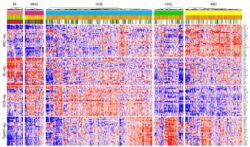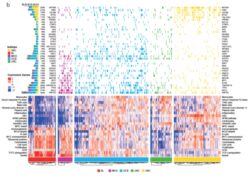Comparison of MHG and DZsig reveals shared biology and a core overlap group with inferior prognosis in DLBCL

Diffuse large B cell lymphoma (DLBCL) is a common cancer that occurs in cells of the immune system, specifically the cells that produce antibodies, called B cells. It commonly appears as tumours (lumps) in lymph nodes, and with the current best treatment many patients will be cured, but up to 40% are not and typically survive less than 5 years from diagnosis.
Like many cancers, DLBCL is regarded as heterogeneous at the molecular and cellular level. This means that while all patients have similar physical symptoms and tumour cells that derive from the same type of normal cell, when we look more closely with modern molecular methods and cellular imaging, we see that there are substantial differences between different patient's tumours.
These can be differences in the underlying genetic cause of the cancer (the DNA of the cancer cells), other differences in the phenotype of the cancer cells, and often importantly, differences in the non-cancer cells within the tumour, particularly immune system cells that can be a natural defense against the disease. We think that these differences in tumour at the cellular and molecular level are part of the reason why treatment works for some patients and not others.

Gene expression patterns, (Sha et al. J. Clin. Oncol. 37(3):202, 2019)
In the last 20 years many groups have investigated the heterogeneity of DLBCL and have discovered sub-types of the disease based on a variety of molecular characteristics of the cells that make up the tumour. In this sequence of studies, using very large data sets of patients from clinical trials and the population in general, we discovered a group of patients who have very poor survival on standard treatments, and called this group 'molecular high grade (MHG)' diffuse large B cell lymphoma. These patients have tumours with a characteristic biology of high tumour cell growth and proliferation, and we are seeking new, innovative and more effective ways to treat them.

Comparison of MHG and DZsig reveals shared biology and a core overlap group with inferior prognosis in DLBCL
Over the next 20 years we expect that the division of this cancer into molecular and cellular subgroups will open the way to more personalized treatment for patients that is more effective, less toxic, and gives a better chance of survival.
Professor Dave Westhead
